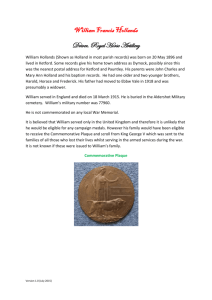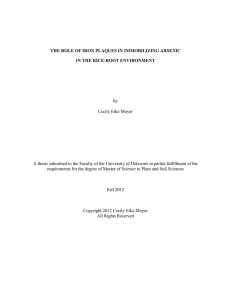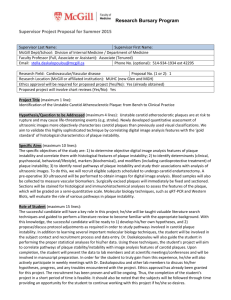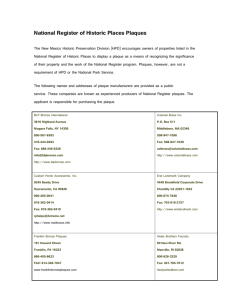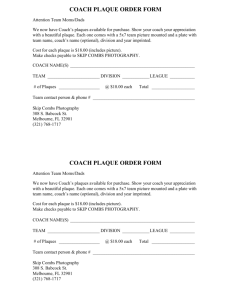Commemorative Green Plaque Report
advertisement
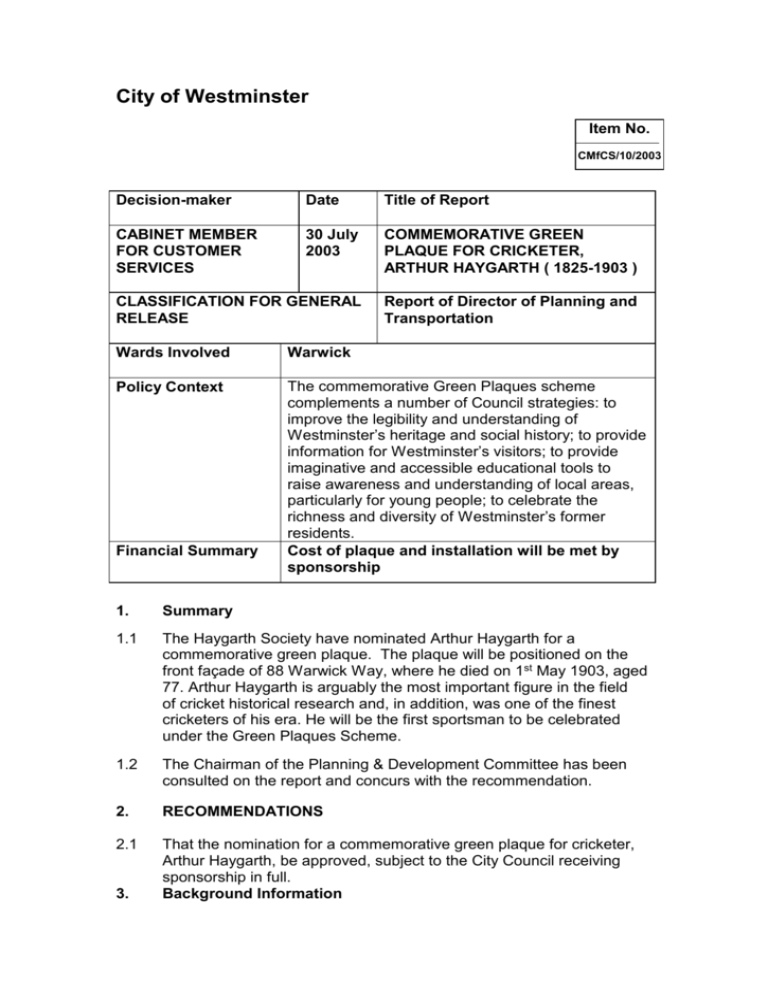
City of Westminster Item No. CMfCS/10/2003 Decision-maker Date Title of Report CABINET MEMBER FOR CUSTOMER SERVICES 30 July 2003 COMMEMORATIVE GREEN PLAQUE FOR CRICKETER, ARTHUR HAYGARTH ( 1825-1903 ) CLASSIFICATION FOR GENERAL RELEASE Report of Director of Planning and Transportation Wards Involved Warwick Policy Context The commemorative Green Plaques scheme complements a number of Council strategies: to improve the legibility and understanding of Westminster’s heritage and social history; to provide information for Westminster’s visitors; to provide imaginative and accessible educational tools to raise awareness and understanding of local areas, particularly for young people; to celebrate the richness and diversity of Westminster’s former residents. Cost of plaque and installation will be met by sponsorship Financial Summary 1. Summary 1.1 The Haygarth Society have nominated Arthur Haygarth for a commemorative green plaque. The plaque will be positioned on the front façade of 88 Warwick Way, where he died on 1st May 1903, aged 77. Arthur Haygarth is arguably the most important figure in the field of cricket historical research and, in addition, was one of the finest cricketers of his era. He will be the first sportsman to be celebrated under the Green Plaques Scheme. 1.2 The Chairman of the Planning & Development Committee has been consulted on the report and concurs with the recommendation. 2. RECOMMENDATIONS 2.1 That the nomination for a commemorative green plaque for cricketer, Arthur Haygarth, be approved, subject to the City Council receiving sponsorship in full. Background Information 3. 3.1 The Green Plaques Scheme was launched in 1991 when a plaque commemorating Winston Churchill was unveiled on Caxton Hall, SW1. By the end of March 2003, 52 plaques had been installed and unveiled. The Scheme is valued by local residents and has been sponsored and supported in the majority of cases by both residents' associations, amenity groups and local businesses. 3.2 Haygarth’s contribution to cricket is enormous. He wrote 15 books on the game’s history and another 19 volumes of his famous “Scores and Biographies”. Although he did not make many runs himself, by keeping up his wicket for hours on the very bad pitches of his time, he enabled his team players opportunities to do so. 4. Detail 4.1 Arthur Haygarth was born in Hastings on 4 August 1825. In 1844 he became a member of the MCC and joined the Marylebone Cricket Club. He generally went on pitch early to take the “sting” out of the bowling. The autumn edition of the “Guide” in 1860 said, “His defence is really perfect, and he will play the best bowling with the greatest science and ease. He will take a long time to get an innings, and is of consequence of great annoyance to his opponents.” At Lord’s, Haygarth’s worth at the wicket was measured not by the runs he scored but by the length of time he took to make them. Ten or twelve runs per hour was his average. 4.2 Haygarth spent many years collecting and arranging scores of all good matches, adding footnotes and remarks and biographical notices. He wrote articles for ‘Cricket’ merely “for the love of the game”. But it is mostly for his compilation of cricket ‘Scores and Biographies’ that he will be remembered. For 60 years he worked loyally on this selfimposed task. ‘Scores and Biographies’ comprises in 14 volumes all the information obtainable from 1746 to 1878, with a supplement concerning notable players for the next 20 years. The volumes appeared at fairly regular intervals between 1862 and 1895. The first four, bound in purple cloth, were published by Frederick Lillywhite, son of William Lillywhite, who was the roundarm bowler without equal, 10 years earlier. The last 11 editions, bound in red cloth, with gilded lettering and ornamented with an armorial design of a shield embodying the stumps, bat and ball, were produced at the sole expense of the Marylebone Club. 4.3 Arthur Haygarth never forgot his school, Harrow School, and assisted with cricket coaching regularly until 1870. The railway was not entirely built at that time and he would regularly walk to Harrow from his home in central London. He served on many M.C.C. committees and was elected a life member in 1864. 4.4 Arthur Haygarth died on 1st May 1903, whilst living at 88 Warwick Way. He is buried at West Brompton Cemetary. The fifteenth and last volume of ‘Scores and Biographies’ did not appear until 23 years later. 5. Financial Implications 5.1 The plaque will cost £170 and installation £100. The Haygarth Society will meet this cost in full. 6. Legal Implications 6.1 Owners and occupiers have accepted standard terms and conditions. No other issues or implications to report. 7. Staffing Implications 7.1 None. 8. Performance Plan Implications 8.1 This nomination will contribute to the quota of up to 5 plaques annually. 9. Consultation 9.1 The owners and occupiers of 88 Warwick Way have been consulted and they support the proposal to mount a plaque commemorating the life and achievements of Arthur Haygarth, on the front façade of the property. The Haygarth Society have also consulted widely amongst their membership and the world of Cricket. A number of letters of support have been received and they are listed as background papers. 9.2 The Chairman of the Planning & Development Committee has been consulted on the report and concurs with the recommendation. 10. Crime and Disorder Act 10.1 No issues arising. 11. Health and Safety Issues 11.1 No issues arising. 12. Human Rights Act 1998 12.1 No issues arising. 13. Reason for Decision 13.1 As a nation, the UK is still pre-eminent in the organisation and administration of sport and sporting events. We have also developed expertise in chronicling sport. Much of our skill in the field of sports organisation comes from the principles laid down in the Victorian era. Westminster has an opportunity, in supporting this nomination, not only to include a sportsman amongst those celebrated by the Green Plaques Scheme, but to acknowledge and celebrate our national achievements in sport and sports administration. Cricket provided the administrative model for the organisation of many other sports. Haygarth’s lasting testimonial, the book Scores and Biographies, was the first great collected record of a sport, a method since copied by Wisden and later for numerous other sports. Arthur Haygarth is considered to be worthy of a Green Plaque, subject to sponsorship in full. The plaque will be unveiled during 2003 which is the centenary year of his death. IF YOU HAVE ANY QUERIES ABOUT THIS REPORT OR WISH TO INSPECT ANY OF THE BACKGROUND PAPERS, PLEASE CONTACT GILLIAN M DAWSON ON 020 7641 2457; EMAIL ADDRESS gdawson@westminster.gov.uk; FAX NUMBER 020 7641 3050 BACKGROUND PAPERS The documents used or referred to in compiling the report were: 1. Committee Reports establishing the Green Plaques Scheme 2. Design of the proposed plaque 3. Photomontage showing plaque on front of building 4. Map showing location of 88 Warwick Way 5. Promotional leaflet for commemorative Green Plaques Scheme 6. letters of consent and support received: a) consent from freeholder, 20.07.02 b) offer of sponsorship from Roger Heavens, 21.08.02 c) letter of support from Alan Victor Jones, 10.04.03 d)letter of support from Colin Roe, 08.04.03 e) letter of support from Mervyn Carson, 11.04.03 f) letter of support from Kenneth Huggett, 12.04.03 g) letter of support from Keith Hayhurst , chairman of Cricket Memorabilia Society, 15.04.03 h) Letter of support from G.C.Brazier, 04.03 i) Letter of support from David Fraser, 21.04.032 j) letter of support from Bill Fletcher, 29.04.03 k) letter of support from Stephen Baldwin l) letter of support from Stephen Beagley, 14.05.03 For completion by Cabinet Member Declaration of Interest I have no interest to declare in respect of this report Signed ……………………………. Date ……………………………… NAME: I have to declare an interest State nature of interest ……..…………………………………………… ……………………………………………………………………………….. Signed ……………………………. Date ………………………………… NAME: (N.B: If you have an interest you should seek advice as to whether it is appropriate to make a decision in relation to this matter.) For the reasons set out above, I agree the recommendation in the report entitled Commemorative Green Plaque for cricketer Arthur Haygarth (1825 - 1903). Signed ……………………………………………… Cabinet Member for ………………………………. Date ………………………………………………… If you have any additional comment which you would want actioned in connection with your decision you should discuss this with the report author and then set out your comment below before the report and this pro-forma is returned to the Secretariat for processing. Additional comment: ………………………………………………………………… …………………………………………………………………………………………. …………………………………………………………………………………………. NOTE: If you do not wish to approve the recommendations, or wish to make an alternative decision, it is important that you consult the report author, the Director of Legal and Administrative Services, the Chief Financial Officer and, if there are staffing implications, the Head of Personnel (or their representatives) so that (1) you can be made aware of any further relevant considerations that you should take into account before making the decision and (2) your reasons for the decision can be properly identified and recorded, as required by law. Note to Cabinet Member: Your decision will now be published and copied to the Members of the relevant Overview & Scrutiny Committee. If the decision falls within the criteria for call-in, it will not be implemented until five working days have elapsed from publication to allow the Overview and Scrutiny Committee to decide whether it wishes to call the matter in.
